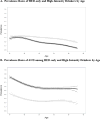High-Intensity Drinking Versus Heavy Episodic Drinking: Prevalence Rates and Relative Odds of Alcohol Use Disorder Across Adulthood
- PMID: 28800154
- PMCID: PMC5626636
- DOI: 10.1111/acer.13475
High-Intensity Drinking Versus Heavy Episodic Drinking: Prevalence Rates and Relative Odds of Alcohol Use Disorder Across Adulthood
Abstract
Background: Heavy episodic drinking (HED) or consuming 4+/5+ drinks in 1 occasion for women/men is linked consistently with alcohol-related harms. Recent research suggests that many individuals drink at levels more than twice this cutoff (8+/10+ drinks), commonly referred to as "high-intensity drinking." Prevalence rates of high-intensity drinking and its dynamic association with alcohol use disorder (AUD) across all ages, however, remain unknown. The current study used data from a nationally representative sample to document age-varying prevalence rates of HED-only drinking and high-intensity drinking, prevalence rates of AUD for HED-only drinkers and high-intensity drinkers, and relative odds of experiencing an AUD for high-intensity drinkers as compared to HED-only drinkers.
Methods: Data were from the National Epidemiologic Survey on Alcohol and Related Conditions-III. The final analytic sample consisted of past-year drinkers aged 18 to 64 years (n = 22,776).
Results: Time-varying effect modeling revealed that high-intensity drinking and HED-only drinking were equally prevalent during young adulthood and prevalence rates of both types of drinking generally became less common with increasing age. At all ages, high-intensity drinkers were at 3 or more times greater odds of meeting criteria for an AUD than HED-only drinkers. The association between high-intensity relative to HED-only drinking was strongest earlier in adulthood with approximately 83% of 18-year-old high-intensity drinkers having AUD relative to 42% of HED-only drinkers.
Conclusions: Future research aiming to identify drinkers most at risk of harms and in need of treatment may benefit from assessing the extent to which an individual exceeds the 8+/10+ threshold of drinking.
Keywords: Alcohol Use Disorder; Heavy Episodic Drinking; High-Intensity Drinking; Time-Varying Effect Modeling; Young Adults.
Copyright © 2017 by the Research Society on Alcoholism.
Conflict of interest statement
The authors have no conflicts of interest to report.
Figures



References
-
- American Psychiatric Association. Diagnostic and Statistical Manual of Mental Disorders. 5th. American Psychiatric Publishing; Arlington, VA: 2013.
-
- Balsa AI, Homer JF, Fleming MF, French MT. Alcohol consumption and health among elders. Gerontologist. 2008;48:622–636. - PubMed
-
- Grant BF, Chu A, Sigman R, Amsbary M, Kali J, Sugawara Y, Jiao R, Ren W, Goldstein R. Source and Accuracy Statement: National Epidemiologic Survey on Alcohol and Related Conditions-III (NESARC-III) National Institute on Alcohol Abuse and Alcoholism; Rockville, MD: 2014.
Publication types
MeSH terms
Grants and funding
LinkOut - more resources
Full Text Sources
Other Literature Sources
Medical
Miscellaneous

